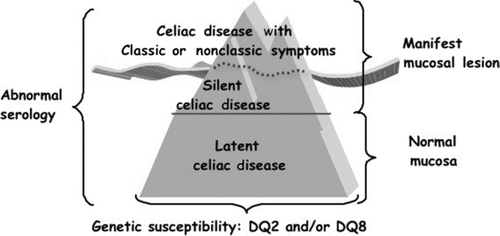Figures & data
FIGURE 2 Prevalence of celiac disease in the US during the last decades [Citation22].
![FIGURE 2 Prevalence of celiac disease in the US during the last decades [Citation22].](/cms/asset/23d2b783-0f8a-4339-bd6a-a6f737d26aeb/iiri_a_602443_f0002_b.gif)
FIGURE 3 A simplified scheme of the adaptive immune response to gluten in celiac disease from gluten ingestion to intestinal damage. (1) Gluten peptides reach the lamina propria via either an increased epithelial tight junctional permeability or epithelial transcytosis. (2) Deamidation of gluten peptides by tissue transglutaminase creates potent immunostimulatory epitopes that (3) bind to HLA-DQ2 or HLA-DQ8 on antigen-presenting cells and (4) activate CD4+ T cells. (5) Activated CD4+ T cells secrete mainly Th1 cytokines, such as IFN-γ, which induces the release and activation of metalloproteases by myofibroblasts, (6) finally resulting in mucosal remodeling and villus atrophy. (7) CD4+ T cells also increase cytotoxicity of intraepithelial lymphocytes or natural killer (NK) T cells, thus leading to enterocyte apoptotic death. (8) Through the production of Th2 cytokines, activated CD4+ T cells also drive the activation and clonal expansion of B cells, which differentiate into plasma cells and produce antibodies to gluten and transglutaminase, contributing to the intestinal damage.

Table 1 Clinical manifestations of celiac disease (CD).
Table 2 Potential novel therapies for celiac disease.

